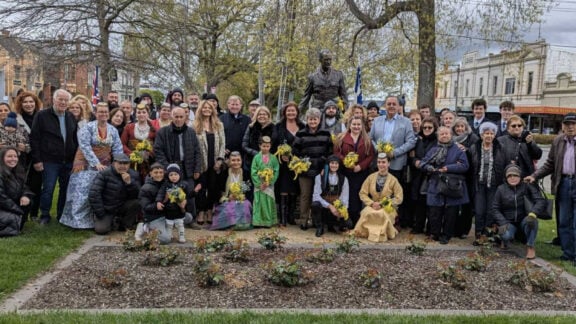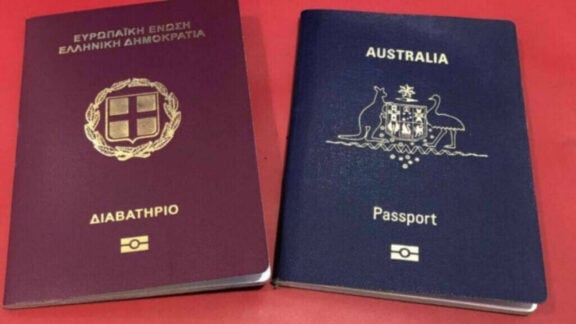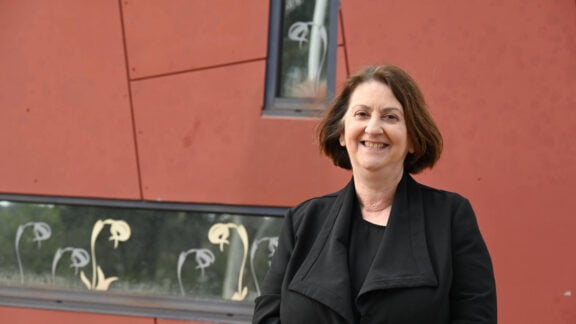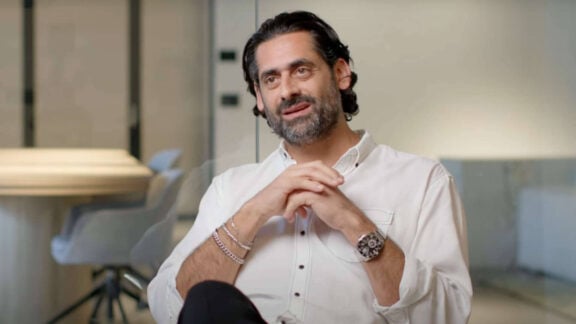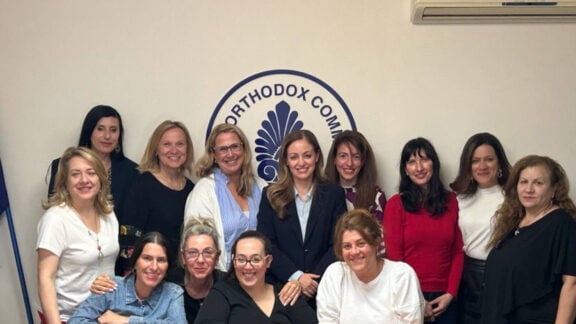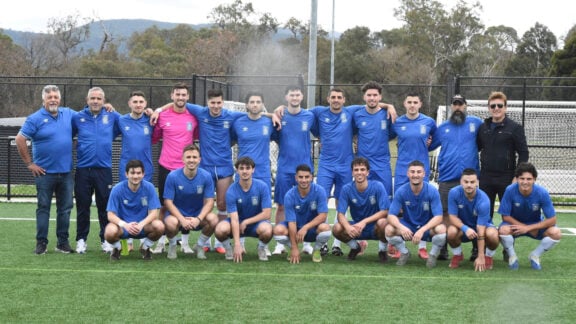It is appropriate that the HANZAC Memorial is finally complete for 28 October 2022.
A five-year project completed. The 28th of October is a special day, a day the valiant Greeks stopped the invaders from entering the homeland. The first of the Allies to defeat an Axis power.
The HANZAC Memorial was officially opened in 2017 by Maria Vamvakinou, the Member for the electorate of Calwell (House of Representatives in Australia). Since then, numerous supporters both military and non-military whose time and donations contributed to make it all possible, have all been acknowledged on marble. The inspiration for the memorial came from the Royal Australian Regiment Memorial located in Brisbane, Queensland, Australia and Lt Col Bastiaan (Australian) who placed at his own expense plaques around the world where Australians fought and died.
There is a stone structure that contains a marble slab with the words Hellenic ANZAC Gardens in English and Greek. This structure along with inner rings are painted in red to symbolise the blood shed fighting for freedom.

The memorial has significant links to an ancient past a time when warriors of old clashed to retain their freedom from tyranny. Therefore, is it not right that like their lion brothers at the gates of Mycenae, that they stand guard at the HANZAC Memorial.
Leading up to the memorial are steps to assist visitors to reach the top. A ramp will be installed in the future for those challenged by the steps. Near the top of the steps there are four Australian Eucalyptus trees named after mates. Left to right, Doug Luik, Barrie Daniels, Bruce Ruxton and Peter Hatherley. The memorial is open to the public free of charge. A tribute to the memories of companions of three nations, Hellas (Greece), Australia & New Zealand. The memorial located directly opposite the Palace of Helen of Troy and husband, Menelaus (Master of the War cry), separated by approximately 500 metres.
In days of old the separation would have been by a vast expanse of water fed by the waterfalls that once fed the mighty Eurotas river. Sad to say that over the centuries that expanse of water has dried up due to earthquakes and the introduction of modern irrigation methodologies which have lowered the water tables. Visitors to the village can still view remnants of those waterfalls when visiting the village of Pellana. One cave waterfall that has now dried up is hidden by a cement brick wall located next to the village bakery. The second waterfall is located in between the home of Stavros Mihalopoulos and that of the Tavern run by Dina Sigalos.
Both waterfalls ran into a huge pool that was housed all fowl of the air and gave livestock the opportunity to drink. The ancient ruins that once stood on this site were unceremoniously removed and deposited in the non perennial stream called Xerilla (500 metres south of the village). Local lore is that there was a tunnel that led down to the waterfall from the ramparts of the palace. Similar to the underground well at Mycenae. One must keep in mind the similarities between Mycenae and that of Pellana. Both were ruled by brother and both had married sisters.

Agamemnon at Mycenae and his brother Menelaus at Pellana. It was to his brother (Agamemnon) that Menelaus sought support to bring back his abducted wife (Helen) from Troy. A venture that the ancients said launched a thousand ships.
It is appropriate that the lions of Pellana standing aloft on the two front pillars of the HANZAC Memorial stand guard. There are fourteen columns, each one representing the fourteen Northern villages of Laconia. Beside the columns are olive trees and bushes lining the Avenue of Honour. The olive trees represent my Uncle Thanasis, Cousin Eleni Stefanopoulo (Who sold the property to me), one to Kostas Sgourdas, Peter (Spitha) Rassias, Nephew William Adamis, amongst others.
The sand beneath the columns represents the beaches at Gallipoli where the ANZACS stormed the heights. Peter Hatherley and Doug Luik laid the foundations of the columns to provide the spectacular look. The idea of the columns was from Kostas Sgourdas – Master Mason. The columns representing the villages are depicted as follows: Pellana, Pardali, Georgitsi, Alevrou, Agorgianni, Loganikos, Agios Kostantinos (Regozena), Kastorio (Kastania), Perivolia, Vordonia, Kastri, Vergadeika, Foundeika & Kyparrisi. Name plaques will be added in due course.
The memorial features five rings. Each ring is symbolic of mankind’s brotherhood and of Olympic symbolism.
1. The first ring contains a chapel indicating mankind’s link with the unknown God. This was built and donated by Kostas Sgourdas. In front of this ring is a flag pole with the Greek flag. On either side of the flag pole are two Australian fig trees, one representing my father and the other my mother.
2. The second ring contains a marble stele with a map of the world where the Diaspora Hellenes have travelled; including the surnames of the village clan surnames.
3. The third ring contains an olive tree. (My father would leave me hanging on the bough of the tree as a toddler to instil in me, ‘Never give up in the face of adversity). The ring also contains my DNA from a thumb injury. Poppy seeds have been planted so that every ANZAC Day the red poppies will appear as well as other flowers being perennially planted. The ring symbolises family and the earth.
4. The fourth ring is the one housing the Hellenes and ANZACS, the meaning of ANZAC Day, mateship, sacrifices by the three nations during WW2, The battles of Greece and Crete, the futility of war, a tribute to Assyrians who died fighting in Greece, a tribute to all those who assisted me in life, a list of my mate’s names, images of a Hellenic, Australian (Aussie soldier who served in Somalia – deceased) and a New Zealand warrior.
A list of those who contributed towards the memorial and finally a special mention to Maurice Barwick, Don Norman (Deceased) and Barrie Daniel, depicting the original four members who began this memorial in 2017. This ring also contains two outer rings painted in red that embrace the urn located in the centre that contains fire. The urn sits on a hollow pedestal which contains material from Thermopylae, Gallipoli, Uluru, Australia, Papua New Guinea, New Zealand, Pellana and the DNA and ashes of Mabs Thrupp (Ex-Army and friend) and of my father. There are also three flags flying on a permanent basis the Hellenic (Host nation) on the left, the Australian in the centre and the New Zealand on the Right.
5. The fifth and last ring contains inner rings that hold fast the stone contains the ODE carved on marble in Greek and in English. The ODE is surrounded by a pool of water which contain gold fish. Stones and roses are to be found on the inner ring around the pool, followed by twelve trees that will grow to great heights to give it the appearance of a cathedral. This last ring is water the symbol for life along with its other two sister, earth and fire.

The circular wall some two metres in height depicts an ancient Mycenaean Lakonian warrior who is accompanied by ANZACS of Gallipoli on the left and right of the warrior. There are also two shields with the emblem (Lamda) upside V which in Greek is the letter ‘L’ meaning Lakonian. The wall is founded upon twelve huge rocks that have been buried deep to hold the structure upright. The wall has also been reinforced by metal bands at the rear and top to withstand minor tremors deep beneath the earth. This wall was donated by mate Don Norman (deceased) and his friend Mavis Tregoning both of Mt Gambier South Australia.
The Guardian’s Wall has etched on a metal plaque all the guardian names of the HANZAC Memorial. The Greek patron is Thanasis Davakis, (Lakonian member of parliament) the Australian patron is Jim Hammett, (Colonel and son of my favourite Commanding Officer: Tony Hammett) and for an inspiring New Zealand, we are still searching for a patron.
The Long Wall of the memorial contains all the names of those ANZACS who died fighting for the citizens of Greece during the Battle of Greece and Crete. There are 1706 names etched on the plaques, glued to marble on the wall. There is also three plaques which contain the history of ancient Pellana, the meaning of the wall, and to those who donated towards making the wall possible.

The HANZAC Memorial is one of the kind in the world containing all of the ANZACS who gave their all during WW2. Their spirits dwell amongst their Hellenic brethren. The name alone speaks for itself.
Within this memorial are the spiritual companions of Hellenes and ANZACS.
The tracks and trails around the memorial depict the Kokoda track of Papua New Guinea as a symbol to the 39th Battalion (Brunswick Citizen soldiers) as well as Thermopylae (Greece) who like their 300 Spartan companions delayed and stemmed the tide of invaders.
The second area of the Memorial is for visitors to sit and relax take photos of the magnificent scenery of the memorial and its surroundings. The mighty Taygetos mountain range to the south west where the sun sets on the village of Pellana and the ancient Palace to the north, the Parnona mountain range and Kouremenos (Baldy) to the east where the sun rises and to the south where the lights of (ancient and) modern Sparta can be seen at night.
This section contains four flag poles, three at the rear and one behind the Lakonian wall. In the centre is a plane (Platano) tree that is now three metre tall. This tree is dedicated to my friends Thelma and Maurice Barwick who were instrumental in assisting me during a time of great personal turmoil. This tree will one day reach great heights and live in excess of 100 years.

Today, the ashes of my mate Donald Norman will be scattered over the memorial. A tribute to a friendship spanning fifty years. As for the family area, there will come the day when funds have been saved to install ablution blocks, permanent seating and BBQ facilities.
This year’s special thanks and acknowledgements to the following people who donated their time and funds to complete the memorial to its current state: Maurice Barwick Don Norman (Deceased), Barrie Daniel, my lovely wife Yovanna, John Kostoulias , Nick Bantounas, Leon Tsongas , Onoufrios Onoufrios Newy Gorozidis , Dr George Vassilopoulos , Peter (Spitha) Rassias, Kostas Sgourdas , Stefanos Sgourdas, Uncle Spiro Dimos and his family, John and Spiro (Stone masons), Thomas Hiitollari (Albanian worker), Peter Hatherley , Douglas Luik Pauline Jonach (Artist), χρηστος Γκλεκας (Chris Glekas), George & Panos Paraskevopoulos, Takis Moutis, Anto-nis Antwnhs Koumaris Dina


